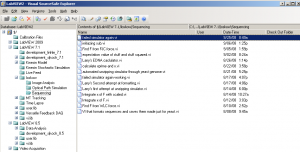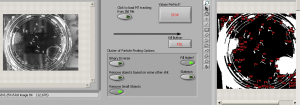The link to Larry’s notebook (pertaining to SDM) is here (this is on a private site, sorry!). His notebook is terribly organized, so going through this takes some time. He does have a public notebook, but that is mostly about microtubule tracking software and kinesin motility simulations.

For your benefits here is a picture of his private notebook. On the right is the 2008 notebook where the information I’m looking for resides. The left is from 2009 which contains information about upgrades and side projects to SDM. For instance the first entry of the year discusses some preliminary research regarding inversions for an application into SDM known as alternative splicing. The last entry of the year (because Larry went public) talks about some upgrades to the original simulation software, basically incorporating some more advanced mathematics into the unzipping energies.
From what I remember about 2008, Larry started designing the software we needed for SDM around July/August so I’ll start there. The paper was submitted to Nature Preceedings January 2009 to give you some scope.
Ok looking through starting Aug 1, I found this (August 6, 2008). This marks the first appearance of anything related to SDM. For those with no access here:
On that page there is a link to yeastgenome.org and Larry talks about how he can’t navigate the site and has no clue what he is doing. I’m guessing things have changed considerably in 3.5 years as I just went there and easily found a list of complete genome sequences for 28 strains of S. cerevisiae. Hoepfully as I look through Larry’s notes I’ll find exactly which strain he downloaded, otherwise I’ll just have to figure something out. Now it’s time to look through his notes and find important stuff. I’ll be back.



